
Home
Services
About us
Blog
Contacts
Custom Mobile App Development for Smart Pet Feeders: Powering Intelligent Pet Care Experiences
1. Introduction: The Evolution of Pet Care in the Digital Age
2. Market Landscape: The Rising Demand for Smart Pet Feeders
3. Core Functionalities: What Users Expect from Smart Pet Feeder Apps
4. Technical Architecture: Building Robust and Scalable Applications
5. Challenges in Developing Smart Pet Feeder Applications
6. Case Studies: Successful Implementations in the Market
7. Why Choose A-Bots.com for Your Smart Pet Feeder App Development
8. Future Outlook: The Next Frontier in Smart Pet Care
9. Conclusion: Embracing Innovation for Enhanced Pet Well-being
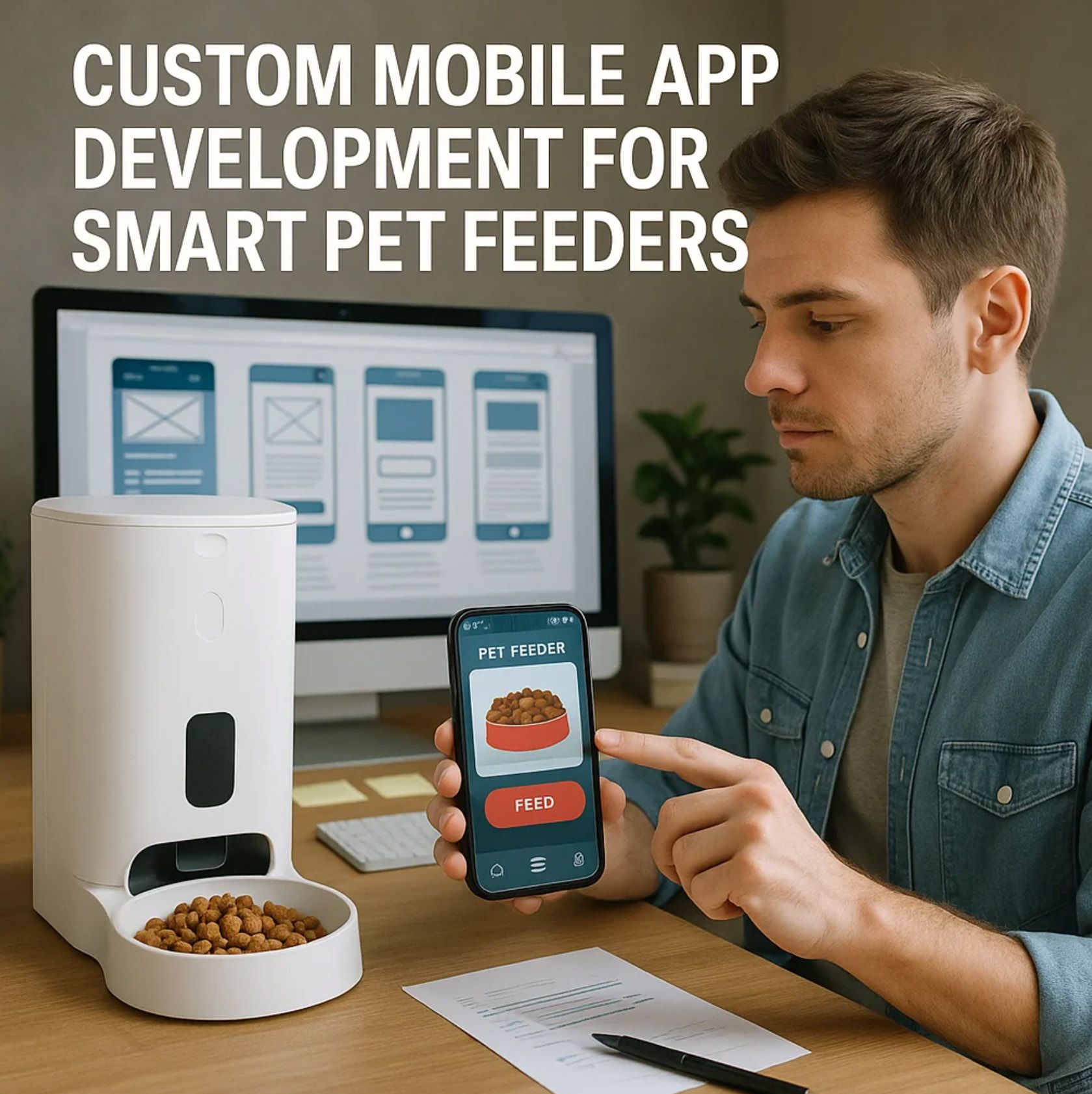
1. Introduction: The Evolution of Pet Care in the Digital Age
In an era where technology seamlessly integrates into every facet of daily life, the realm of pet care is no exception. The advent of smart pet feeders and water dispensers has revolutionized how pet owners ensure the well-being of their furry companions. These devices, equipped with advanced features and controlled via mobile applications, offer unparalleled convenience and peace of mind.
The global market for smart pet feeders is experiencing significant growth. Valued at approximately $1.46 billion in 2024, it is projected to reach $2.35 billion by 2030, growing at a compound annual growth rate (CAGR) of 8.46% . This surge is attributed to increasing pet ownership, heightened awareness of pet health and nutrition, and the demand for convenient pet care solutions (GlobeNewswire).
North America leads this market, accounting for 54.9% of global revenue in 2024 . The region's dominance is driven by busy lifestyles and the widespread adoption of smart home technologies. According to the American Pet Products Association, over 70% of U.S. households own pets, underscoring the vast potential for smart pet care devices (Grand View Research).
Smart pet feeders offer features such as scheduled feeding, portion control, and real-time monitoring through mobile apps. These functionalities not only ensure pets receive timely and appropriate meals but also allow owners to monitor and adjust feeding routines remotely. Advanced models incorporate cameras and two-way audio, enabling interaction with pets from afar.(GlobeNewswire, Precedence Research).
The integration of mobile applications is pivotal in enhancing the user experience. Apps provide intuitive interfaces for setting feeding schedules, monitoring food levels, and receiving notifications. They also facilitate firmware updates and integration with other smart home systems. The emphasis on user-friendly design and seamless connectivity is crucial for widespread adoption.
As the market continues to expand, manufacturers of smart pet feeders and water dispensers are seeking reliable partners to develop custom mobile applications that align with their hardware offerings. Companies like A-Bots.com specialize in creating tailored software solutions that enhance device functionality and user engagement. By leveraging expertise in IoT and mobile app development, these collaborations aim to deliver comprehensive pet care experiences that resonate with modern consumers.
The evolution of pet care through smart devices and mobile applications reflects a broader trend of integrating technology into everyday life. The growing market for smart pet feeders underscores the importance of innovative solutions that cater to the needs of both pets and their owners. As demand continues to rise, the collaboration between hardware manufacturers and software developers will be instrumental in shaping the future of intelligent pet care.
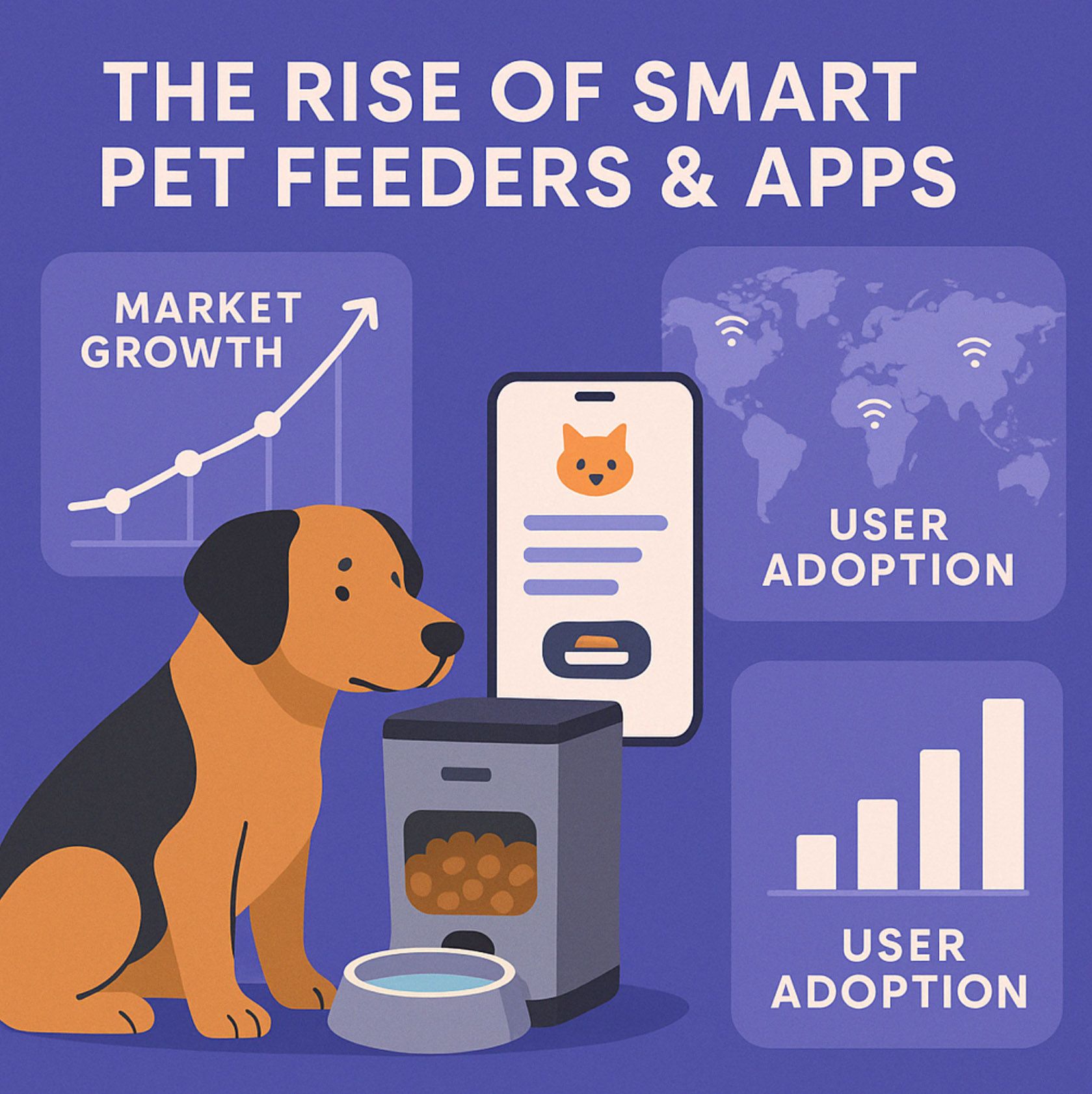
2. Market Landscape: The Rising Demand for Smart Pet Feeders
The global smart pet feeder market is experiencing significant growth, driven by technological advancements and changing consumer lifestyles. In 2024, the market was valued at approximately $1.46 billion and is projected to reach $2.35 billion by 2030, growing at a CAGR of 8.46% . This growth reflects the increasing demand for automated pet care solutions that offer convenience and enhance pet well-being.
North America: Leading the Market
North America dominates the smart pet feeder market, accounting for 54.9% of global revenue in 2024 . This dominance is attributed to several factors:
- High Pet Ownership: Over 70% of U.S. households own pets, indicating a substantial market for pet care products.
- Busy Lifestyles: With many individuals working full-time, there's a growing need for automated solutions to manage pet care routines.
- Technological Adoption: The widespread use of smartphones and smart home devices facilitates the integration of smart pet feeders into daily life.
In the U.S., the smart pet feeder market was valued at $601.38 million in 2024 and is expected to reach $940.94 million by 2030, growing at a CAGR of 8.08% (researchandmarkets.com).
Europe: Embracing Innovation
Europe represents a lucrative market for smart pet feeders, driven by:
- E-commerce Growth: The increasing penetration of online shopping platforms makes it easier for consumers to access smart pet care products.
- Focus on Pet Health: European consumers are placing greater emphasis on pet well-being, seeking products that offer health monitoring and dietary management.
- Technological Advancements: Companies like New Pet in Town and Pawbo are introducing innovative feeders with features like app-based monitoring and high-precision scales.
Asia-Pacific: Rapid Expansion
The Asia-Pacific region is anticipated to grow at the fastest rate, with a projected CAGR of 9.10% during the forecast period . Key factors include:
- Urbanization: As more people move to urban areas, there's a growing demand for convenient pet care solutions.
- Technological Integration: Products like Furspark's Big Eye, featuring AI-driven monitoring and high-definition imaging, cater to tech-savvy consumers.
- Pet Humanization: In countries like Japan, pets are increasingly viewed as family members, leading to higher spending on premium pet care products.
Latin America and Middle East & Africa: Emerging Markets
These regions are witnessing growth due to:
- Increasing Pet Ownership: More households are adopting pets, creating a demand for pet care products.
- Technological Adoption: The rising availability of smart devices and internet connectivity facilitates the use of smart pet feeders.
- E-commerce Expansion: Online platforms are making it easier for consumers to access a variety of pet care products.
Market Drivers
Several factors are propelling the growth of the smart pet feeder market:
- Convenience: Automated feeders allow pet owners to manage feeding schedules remotely, accommodating busy lifestyles.
- Health Monitoring: Advanced feeders offer features like portion control and dietary tracking, promoting pet health.
- Technological Advancements: Integration with mobile apps, Wi-Fi connectivity, and AI capabilities enhance user experience.
- Pet Humanization: As pets are increasingly considered family members, owners are more willing to invest in premium care products.
The smart pet feeder market is poised for continued growth, driven by technological innovations and changing consumer behaviors. Manufacturers aiming to capitalize on this trend must focus on developing products that offer convenience, health benefits, and seamless integration with modern technology. Collaborations with experienced software developers, like A-Bots.com, can be instrumental in creating custom mobile applications that enhance product functionality and user engagement.
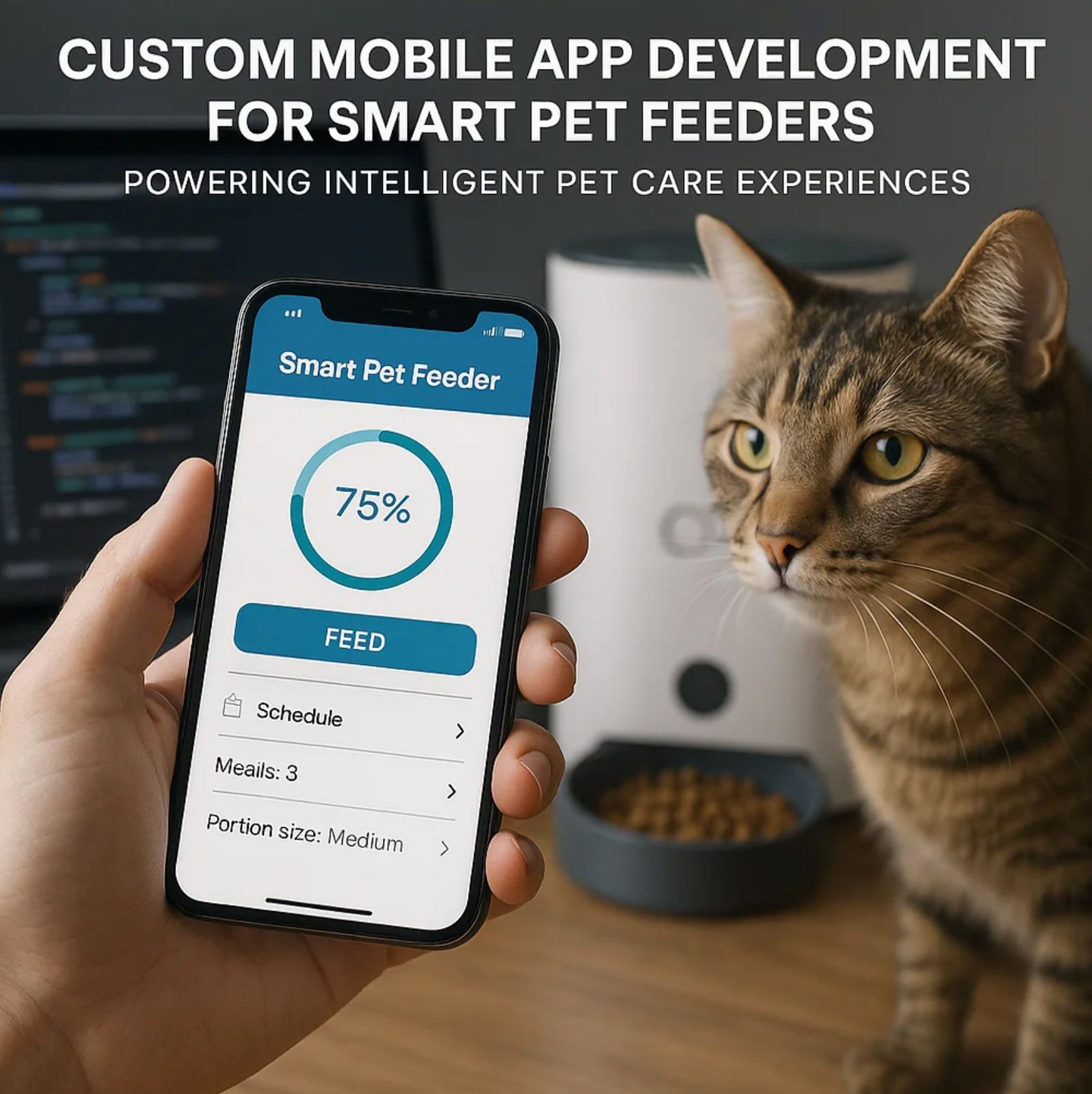
3. Core Functionalities: What Users Expect from Smart Pet Feeder Apps
In the rapidly evolving landscape of pet care technology, smart pet feeder mobile applications have become indispensable tools for pet owners seeking convenience, control, and peace of mind. These applications serve as the bridge between sophisticated hardware and user-friendly interfaces, enabling seamless interaction and management of pet feeding routines.
1. Feeding Schedule Management
One of the primary expectations from smart pet feeder apps is the ability to create and manage feeding schedules. Users desire flexibility in setting meal times, portion sizes, and frequency to align with their pets' dietary needs. For instance, the Catit PIXI Smart Feeder allows users to schedule up to 12 meals per day, ensuring pets are fed consistently even when owners are away.
Moreover, the inclusion of features like "Slow Feed" modes, as seen in the PetSafe Smart Feed, helps prevent rapid eating by dispensing meals in small increments over a set period, promoting healthier eating habits (petsafe.com).
2. Real-Time Notifications and Alerts
Timely notifications are crucial for maintaining effective pet care routines. Users expect alerts for various events, such as successful meal dispensing, low food levels, or device malfunctions. The Talo Automatic Wi-Fi Pet Feeder, for example, sends push notifications when the food reservoir is running low, allowing owners to refill promptly and avoid missed meals.
These real-time updates not only ensure pets are fed on time but also provide owners with reassurance about their pets' well-being, especially during extended periods away from home.
3. Manual Feeding Controls
Beyond scheduled feedings, users appreciate the ability to dispense food manually through the app. This feature is particularly useful for rewarding pets or accommodating unexpected changes in routine. Devices like the PAPIFEED Smart Automatic Cat Feeder offer remote feeding capabilities, allowing owners to feed their pets from anywhere using the associated mobile application (WIRED, Amazon).
4. Integration with Smart Home Ecosystems
As smart home technology becomes more prevalent, users expect their pet feeder apps to integrate seamlessly with existing ecosystems. Compatibility with voice assistants like Amazon Alexa and Google Assistant enables hands-free operation, enhancing user convenience. For instance, the Aqara Smart Pet Feeder C1 can be controlled via voice commands when integrated into the Aqara Home scene, providing users with flexible feeding options (Aqara).
Such integrations not only streamline pet care routines but also position smart pet feeders as integral components of the connected home environment.
5. Multi-User Access and Shared Profiles
In households with multiple caregivers, the ability to share access to the pet feeder app is essential. Shared profiles prevent overlapping feedings and ensure consistent care. A UX case study highlighted that 90% of users shared pet care responsibilities, underscoring the importance of multi-user functionality in app design (Medium).
Implementing features that allow multiple users to manage feeding schedules and monitor pet health fosters collaboration and reduces the likelihood of errors.
6. User-Friendly Interface and Experience
A well-designed user interface is critical for user satisfaction and engagement. Apps should offer intuitive navigation, clear visuals, and responsive controls to cater to users of varying technical proficiencies. The Catit PIXI app, for example, provides a straightforward interface for scheduling meals and monitoring feeding history, enhancing user experience (catit.com).
Furthermore, incorporating features like customizable pet profiles, feeding history logs, and visual indicators for food levels can enrich the user experience and provide valuable insights into pet health and behavior.
Smart pet feeder mobile applications are expected to offer comprehensive functionalities that address the diverse needs of pet owners. By focusing on features such as flexible scheduling, real-time notifications, manual controls, smart home integration, multi-user access, and user-friendly interfaces, developers can create applications that not only enhance pet care but also align with modern lifestyles.
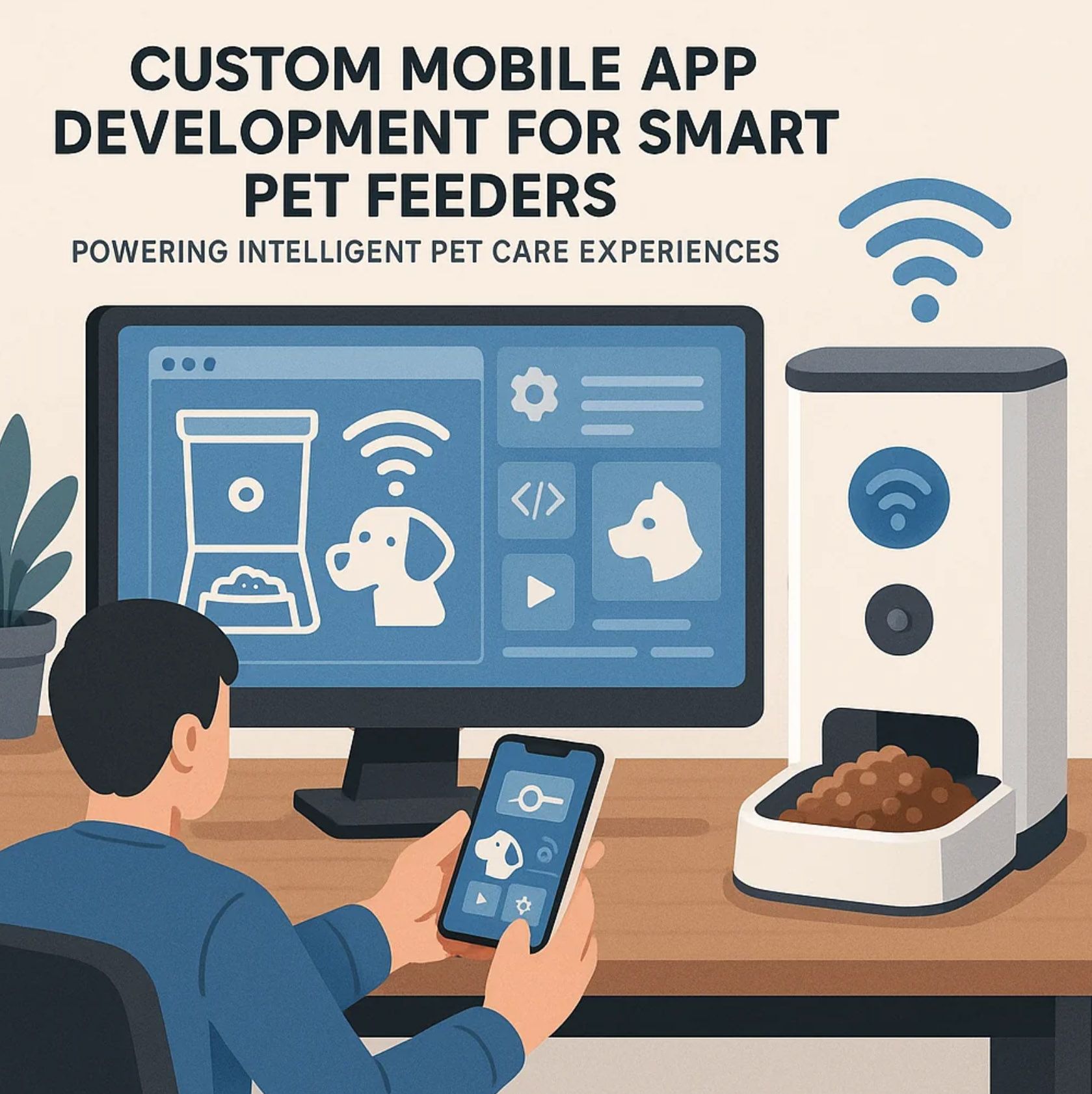
4. Technical Architecture: Building Robust and Scalable Applications
Developing a reliable and scalable mobile application for smart pet feeders requires a comprehensive understanding of both hardware integration and software development. This section delves into the critical components and considerations involved in creating a seamless user experience.
1. Hardware Integration
At the core of any smart pet feeder is the integration of various hardware components that work in unison to automate feeding processes. Key elements include:
- Microcontrollers: Devices like Raspberry Pi or Arduino serve as the brain of the feeder, controlling operations and facilitating communication between components.
- Sensors: Weight sensors ensure accurate portion control, while ultrasonic sensors detect pet presence, and cameras provide visual monitoring.
- Actuators: Servo motors manage the dispensing mechanism, releasing precise amounts of food as scheduled.
The synchronization of these components is vital for the feeder's functionality, requiring meticulous calibration and testing.
2. Connectivity and Communication
Ensuring seamless communication between the mobile application and the feeder hardware is paramount. This involves:
- Wi-Fi and Bluetooth Modules: Facilitate real-time data exchange and remote control capabilities.
- Cloud Services: Platforms like Azure IoT Hub or AWS IoT Core manage data storage, processing, and device management.
- APIs: Custom APIs enable the mobile application to interact with the feeder, sending commands and retrieving status updates.
Implementing robust communication protocols ensures reliability and responsiveness in various network conditions.
3. Software Development
The mobile application's software architecture must be designed for scalability, maintainability, and user-friendliness. Considerations include:
- Modular Design: Separating functionalities into distinct modules (e.g., scheduling, monitoring, notifications) enhances code manageability.
- Cross-Platform Compatibility: Utilizing frameworks like React Native or Flutter allows for simultaneous development for iOS and Android platforms.
- User Interface (UI) and User Experience (UX): Designing intuitive interfaces with clear navigation and responsive controls improves user engagement.
Adhering to best practices in software development ensures a robust and adaptable application.
4. Security and Privacy
Given the sensitive nature of user data and the potential risks associated with IoT devices, implementing stringent security measures is non-negotiable. Key aspects include:
- Data Encryption: Employing protocols like SSL/TLS to secure data transmission between the application, cloud services, and hardware.
- Authentication and Authorization: Implementing secure login mechanisms and access controls to prevent unauthorized usage.
- Regular Updates: Ensuring the application and firmware receive timely updates to patch vulnerabilities.
Neglecting security can lead to severe consequences, including unauthorized access to devices and data breaches.
5. Scalability and Maintenance
As user bases grow and new features are introduced, the application must be scalable and easy to maintain. Strategies include:
- Cloud Infrastructure: Leveraging scalable cloud services to handle increased data loads and user interactions.
- Continuous Integration/Continuous Deployment (CI/CD): Implementing CI/CD pipelines for efficient testing and deployment of updates.
- Monitoring and Analytics: Integrating tools to monitor application performance and user behavior, facilitating data-driven improvements.
Proactive maintenance and scalability planning ensure long-term success and user satisfaction.
Developing a smart pet feeder application involves a multifaceted approach that encompasses hardware integration, reliable connectivity, secure and scalable software development, and ongoing maintenance. By addressing these technical aspects diligently, developers can deliver a product that meets user expectations and stands out in the competitive pet tech market.
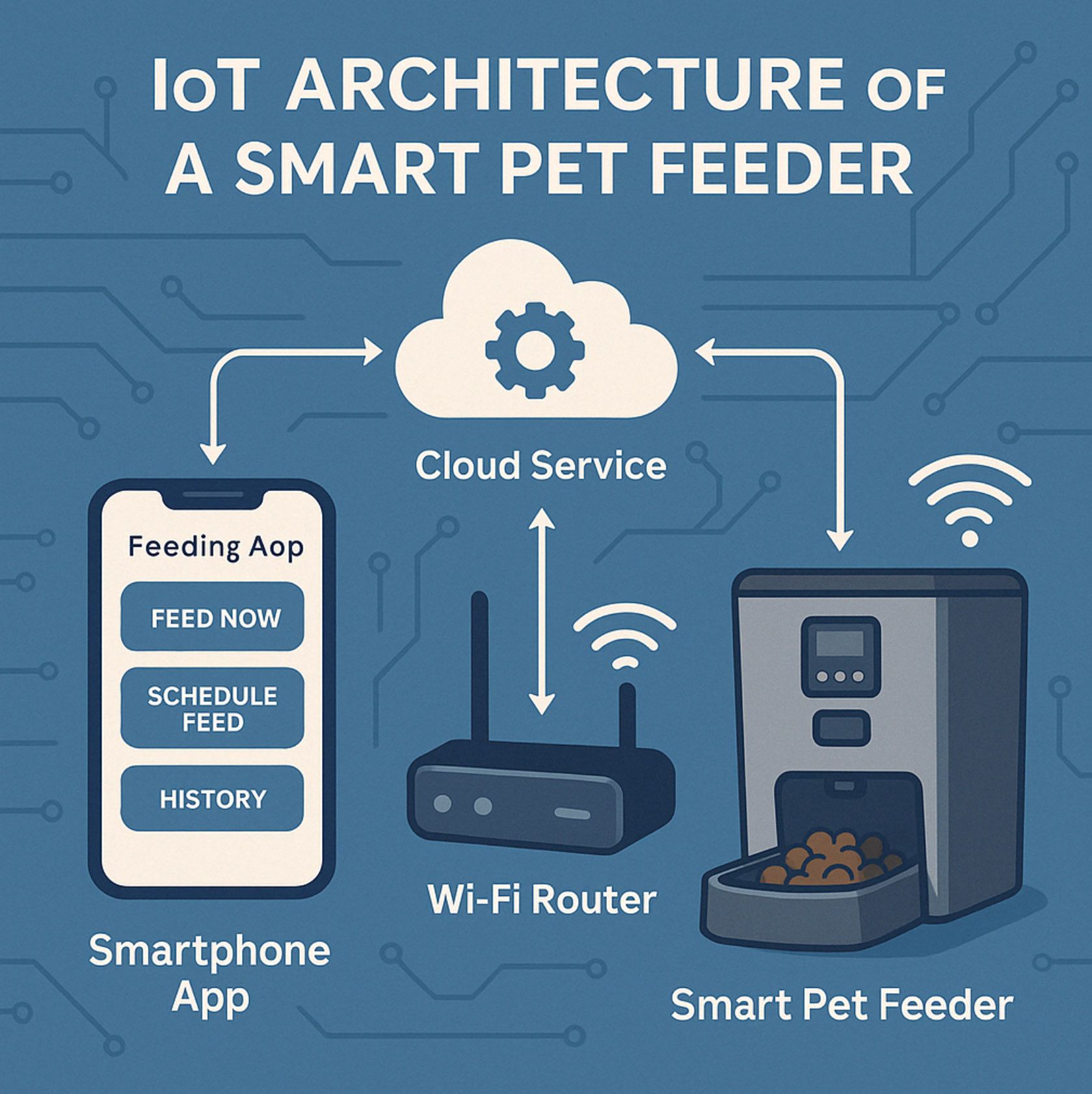
5. Challenges in Developing Smart Pet Feeder Applications
While the smart pet feeder market is burgeoning, developers face several challenges in creating applications that are reliable, secure, and user-friendly. Addressing these challenges is crucial for delivering a seamless experience to pet owners and ensuring the well-being of their pets.
1. Ensuring Reliable Connectivity
Smart pet feeders rely heavily on consistent internet connectivity to function correctly. However, network instability can lead to delayed or missed feedings, causing distress to both pets and owners. For instance, users have reported instances where feeders failed to dispense food due to connectivity issues, highlighting the need for robust offline functionalities and fail-safes.
2. Addressing Security Vulnerabilities
Security is a paramount concern in IoT devices. Studies have uncovered vulnerabilities in smart pet feeders, such as hard-coded credentials and insecure firmware updates, which can be exploited to gain unauthorized access to devices and sensitive user data. Implementing strong encryption, regular security audits, and secure authentication mechanisms is essential to protect users and their pets.
3. Managing Power Dependencies
Smart feeders often depend on continuous power supply. Power outages or battery failures can disrupt feeding schedules, potentially endangering pets' health. Developers must design systems with backup power solutions and alert mechanisms to notify users of power issues promptly.
4. Ensuring Hardware-Software Compatibility
Integrating software with diverse hardware components poses compatibility challenges. Variations in sensors, motors, and other components require adaptable software solutions. Standardizing communication protocols and thorough testing across different hardware configurations can mitigate these issues.
5. Navigating Regulatory Compliance
Developers must ensure that smart pet feeders comply with various regulations concerning data privacy and electronic devices. Non-compliance can lead to legal repercussions and loss of consumer trust. Staying informed about regulatory changes and incorporating compliance measures into the development process is vital.
6. Providing Robust Customer Support
Effective customer support is crucial for addressing user concerns and maintaining satisfaction. Instances of inadequate support, such as unresponsive customer service channels, can damage a company's reputation. Establishing responsive support systems and clear communication channels is essential for user retention.
Developing smart pet feeder applications involves navigating a complex landscape of technical, security, and regulatory challenges. By proactively addressing these issues, developers can create reliable and secure applications that meet the needs of pet owners and contribute to the growth of the smart pet care industry.
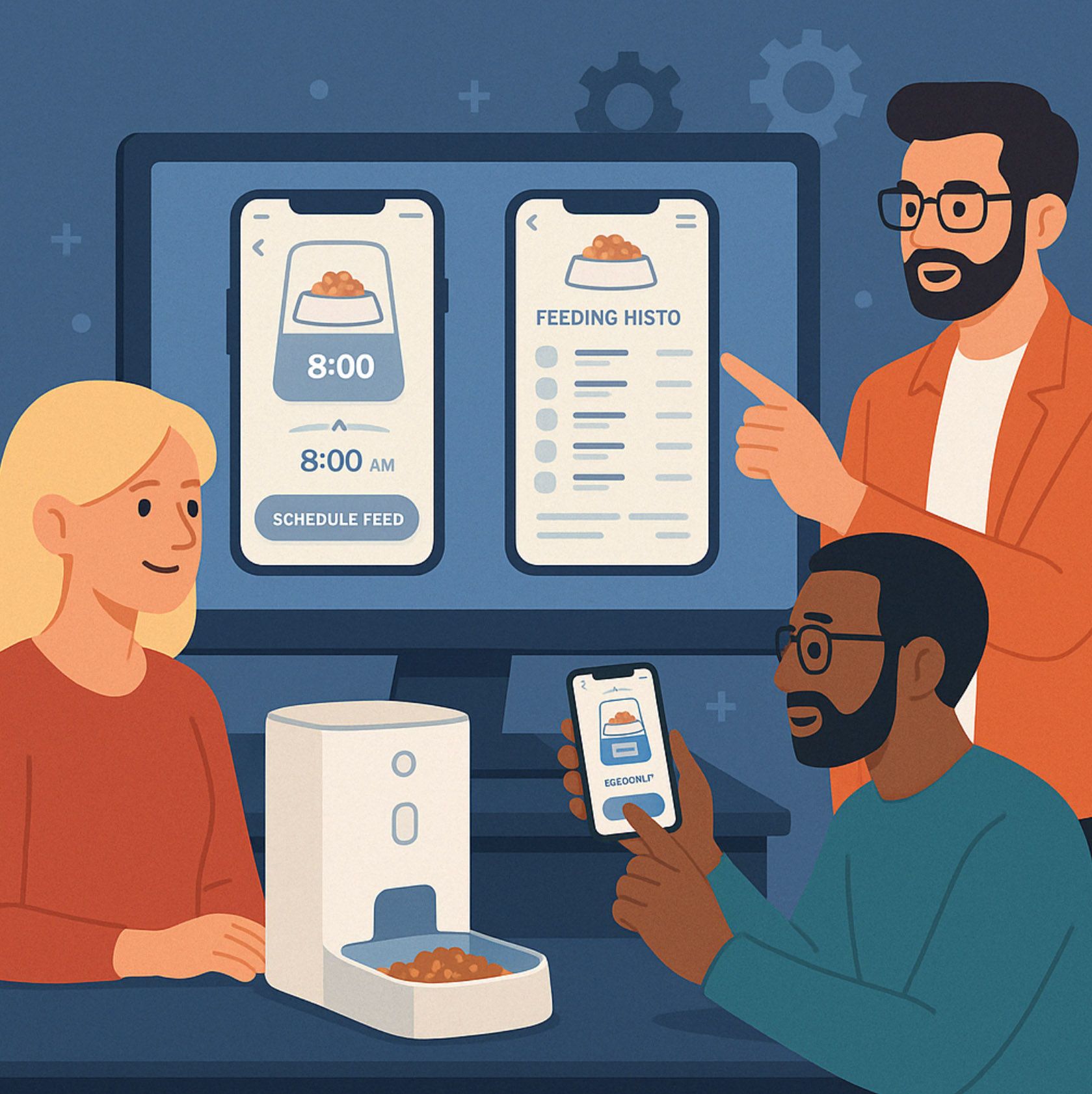
6. Case Studies: Successful Implementations in the Market
As the smart pet feeder market matures, a handful of brands have managed to stand out — not just through sleek hardware, but by pairing their devices with mobile applications that deliver practical value to pet owners. Studying these implementations reveals both the progress already made and the white space that still remains wide open for innovation. Let’s take a closer look at some of the most notable examples.
One of the most widely adopted products in the U.S. is the PetSafe® Smart Feed Automatic Pet Feeder, a Wi-Fi enabled device that offers portion control, scheduling, and smartphone alerts. It integrates with the My PetSafe app, allowing users to program up to 12 meals per day. The app’s interface is clean and user-friendly, and its “Slow Feed” option has been praised by veterinarians. However, the platform has limitations: it lacks multi-user access and offers no insights into eating behavior over time — an opportunity for custom app developers to introduce advanced analytics and family sharing models.
Another prominent player is WOPET, which offers a range of smart feeders including models with HD cameras and two-way voice communication. Their app supports real-time video streaming and manual feeding via smartphone, adding a strong emotional dimension for owners who travel frequently or work long hours. Yet despite its emotional resonance, the WOPET app is often criticized for connectivity issues and unintuitive setup flows. This highlights the importance of robust onboarding flows, OTA firmware coordination, and graceful error recovery — all hallmarks of custom, enterprise-level mobile applications.
In the European market, Petlibro has gained traction for its elegant product design and reasonably reliable mobile experience. Their smart feeder supports Alexa integration, allowing voice control of feeding functions. However, while technically impressive, the app has been slow to evolve. Feature rollouts are rare, and localization options remain limited. This presents a clear opportunity: manufacturers that invest in a well-supported, continuously updated mobile app with region-specific features (language, feeding patterns, pet type preferences) can capture underserved global segments.
On the innovation front, Feeder-Robot by Whisker deserves mention. While still in development stages compared to the company’s flagship Litter-Robot, the brand’s ambition is noteworthy: complete home automation for pets. Whisker’s Connect app aims to unify multiple pet care devices under one smart hub — a concept that aligns with the emerging trend of pet tech ecosystems. If successful, this will demand highly modular, API-driven mobile architecture — exactly the type of work companies like A-Bots.com are built to handle.
What do these case studies reveal? First, that hardware alone is not enough. Even the most advanced feeders fall short when paired with mediocre apps. Second, that market leaders often plateau — once they ship a working version, they rarely iterate. And finally, that users are ready for more. They want better data, smarter routines, voice control, home assistant integration, shared profiles, real-time alerts, predictive insights, and above all — trust.
This is precisely where custom mobile applications come into play. While off-the-shelf platforms cover the basics, the brands that will dominate tomorrow’s smart pet care market are those who see software as their main product, not a supporting utility.
And for those who don’t have in-house mobile teams — there are partners like A-Bots.com. A-Bots.com is mobile application development.
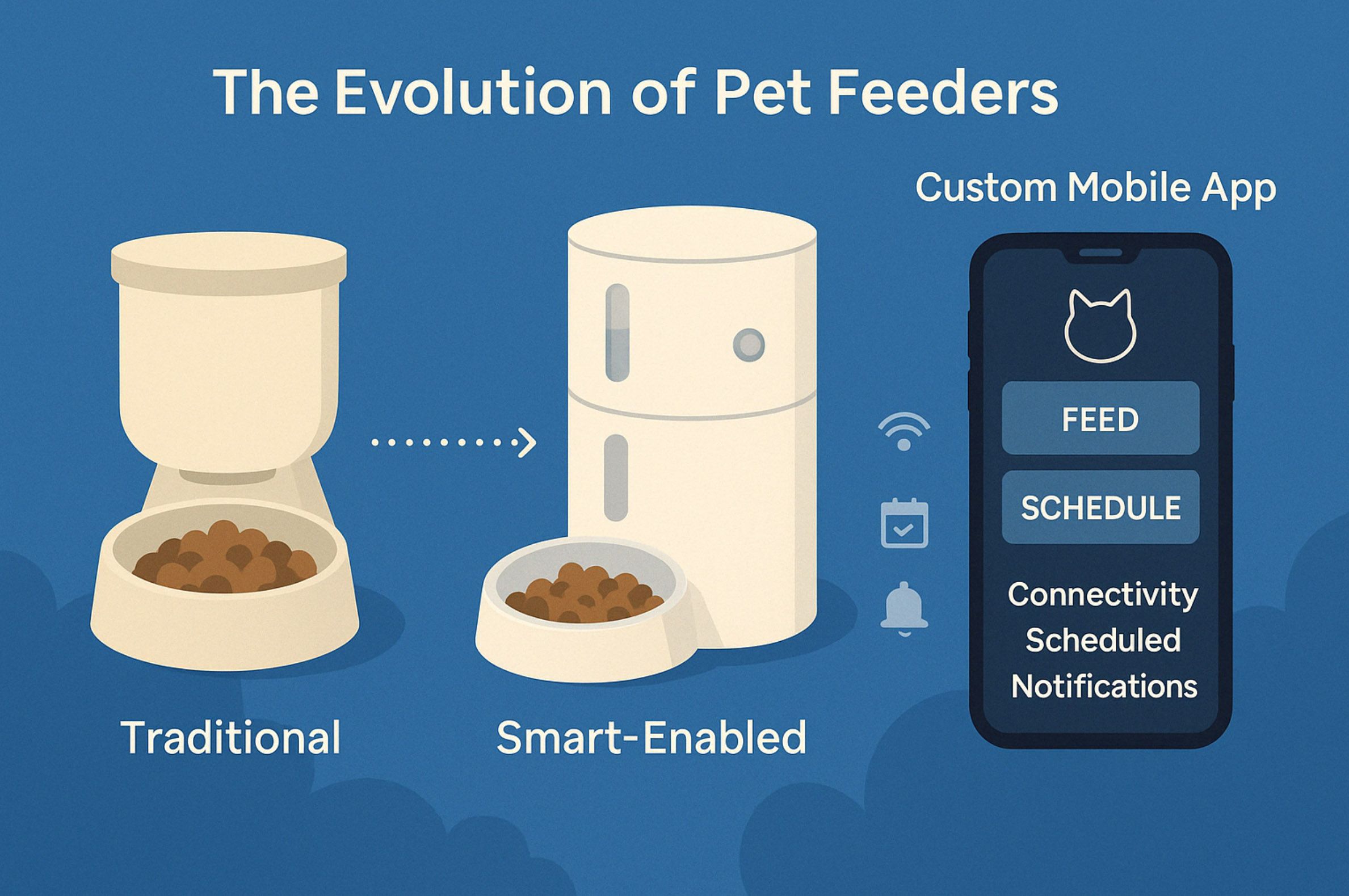
7. Why Choose A-Bots.com for Your Smart Pet Feeder App Development
In the smart pet feeder industry, great hardware is expected. What differentiates market leaders from the rest isn’t the number of meals dispensed or the megapixels on the built-in camera — it’s the quality of the software that powers the experience. It’s the app that determines whether users feel empowered, in control, and emotionally connected to the product. This is where A-Bots.com brings transformative value.
Unlike generalized software agencies or offshore app factories, A-Bots.com specializes in custom mobile applications for connected devices. We focus on the edge where software meets hardware — where UX meets embedded systems — and where everyday reliability is more important than flashy features. Smart pet feeders demand exactly this kind of thinking: apps that quietly do their job, anticipate failure modes, and gracefully recover when real-world conditions get messy.
Our team has deep expertise in IoT architecture, from BLE and Wi-Fi protocols to device-cloud synchronization, OTA firmware update orchestration, and app-based diagnostics. But more than that, we understand what it means to build for trust. Feeding a pet isn’t just an interaction — it’s a commitment. That means your app can’t be “just okay.” It must be resilient, predictable, and emotionally intuitive. That’s the bar we work to exceed.
We also understand that every product is unique, and your brand deserves more than a white-labeled template. That’s why our approach is fully custom. We start by mapping out your device’s technical stack, your market positioning, and your business model. Then we co-design an app experience that fits your brand like a glove — from UI aesthetics to feature flow logic, from multilingual support to regulatory compliance.
Need advanced features like voice assistant integration, AI-powered feeding analytics, or multi-device control dashboards for commercial clients? We’ve built them. Want a single codebase for iOS and Android, optimized for performance and OTA support? We do that too. Looking to integrate with Amazon’s smart home ecosystem or launch your product globally with region-specific settings? We’ll architect it from the start.
But technology alone isn’t enough. What makes A-Bots.com the right partner is our alignment with your long-term goals. We’re not here to ship code and disappear. We offer versioned development cycles, support for iterative scaling, and dedicated teams that stay with you post-launch to ensure your app evolves alongside your product line and user base.
In a market as competitive and emotionally driven as pet tech, success depends on more than mechanics. It requires delivering an experience that feels seamless, responsive, and alive. That’s what we build — and that’s why leading brands trust us with their most user-sensitive applications.
Let your hardware feed the pets. Let us feed the experience.
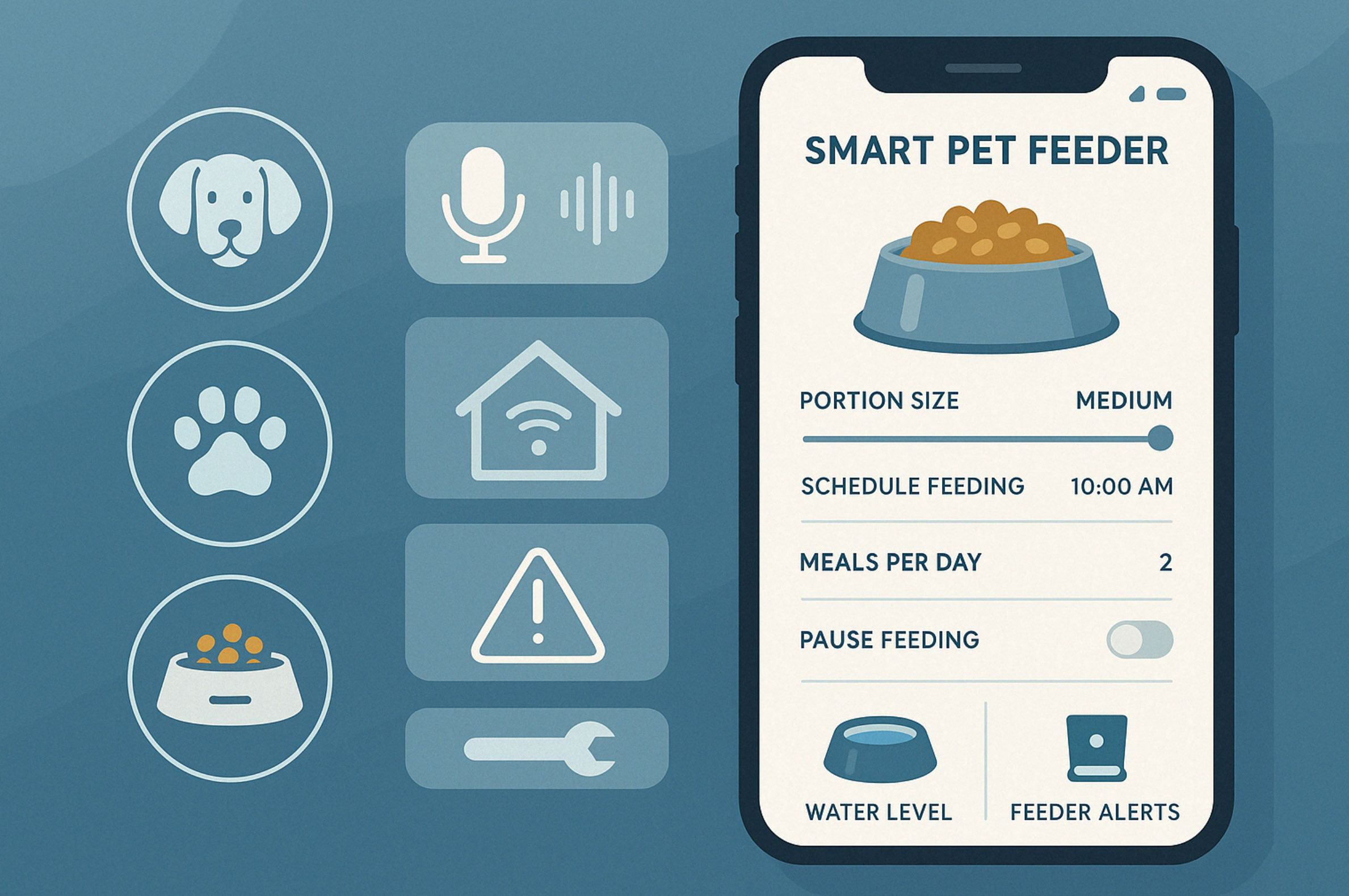
8. Future Outlook: The Next Frontier in Smart Pet Care
The trajectory of smart pet care is clear — and it points far beyond scheduled feedings or mobile alerts. What began as a convenience product for busy pet owners is rapidly becoming an intelligent, integrated ecosystem where pets’ well-being is managed through sensors, data, and behavioral algorithms. The next generation of smart feeders will not just dispense food — they will understand the pet, adapt to its needs, and even collaborate with other smart systems in the home.
At the forefront of this shift is predictive and personalized care. Just as wearables now help humans optimize health through passive data collection, smart pet feeders will increasingly incorporate insights from usage patterns, motion sensors, and even AI-enhanced cameras to detect changes in appetite, behavior, or schedule. A drop in consumption may no longer be dismissed as a fluke — it could trigger a nutritional warning or a prompt to consult a veterinarian. This is where software becomes not just a control panel, but a partner in care.
Integration will also deepen. Today’s feeders often exist as standalone products, but the demand is growing for cross-device synergy — feeding coordinated with smart water dispensers, pet doors, cameras, climate control, or GPS collars. A truly smart pet environment will orchestrate all these devices through shared data and unified interfaces. For manufacturers, this means building apps that are modular, API-ready, and extensible — capable of talking not just to the feeder, but to a whole pet tech ecosystem.
Voice interaction is another area of rapid adoption. As more homes integrate voice assistants like Alexa or Google Home, users expect pet devices to respond naturally to voice commands: “Feed Luna a half-portion at 7 PM” or “Has Max eaten today?” This demands not only smart voice command handling, but also natural language understanding, personalization, and secure authentication. For many manufacturers, this is an entirely new software challenge — and a major opportunity for differentiation.
From the business side, the future lies in subscription services and smart data monetization. With accurate consumption data, apps can offer auto-refill integration with pet food vendors, proactive veterinary alerts, or even custom diet recommendations based on breed, age, and seasonal activity. These services can generate new revenue streams while deepening user loyalty — but only if supported by a software platform that’s robust, secure, and extensible.
Finally, the role of AI will expand. From anomaly detection in feeding behavior to auto-adjusting portion sizes during growth cycles or weight control programs, machine learning will allow feeders to go from passive appliances to active caregivers. Brands that invest now in AI infrastructure — or partner with firms that can implement it — will be the ones defining the premium pet tech market five years from now.
In short, the next frontier is not about simply feeding pets better. It’s about building responsive, intelligent systems that make pet ownership smarter, safer, and more emotionally connected. And that evolution is already underway.
Manufacturers who embrace this shift — and build the right software backbone — won’t just sell more devices.
They’ll shape the future of how we care.
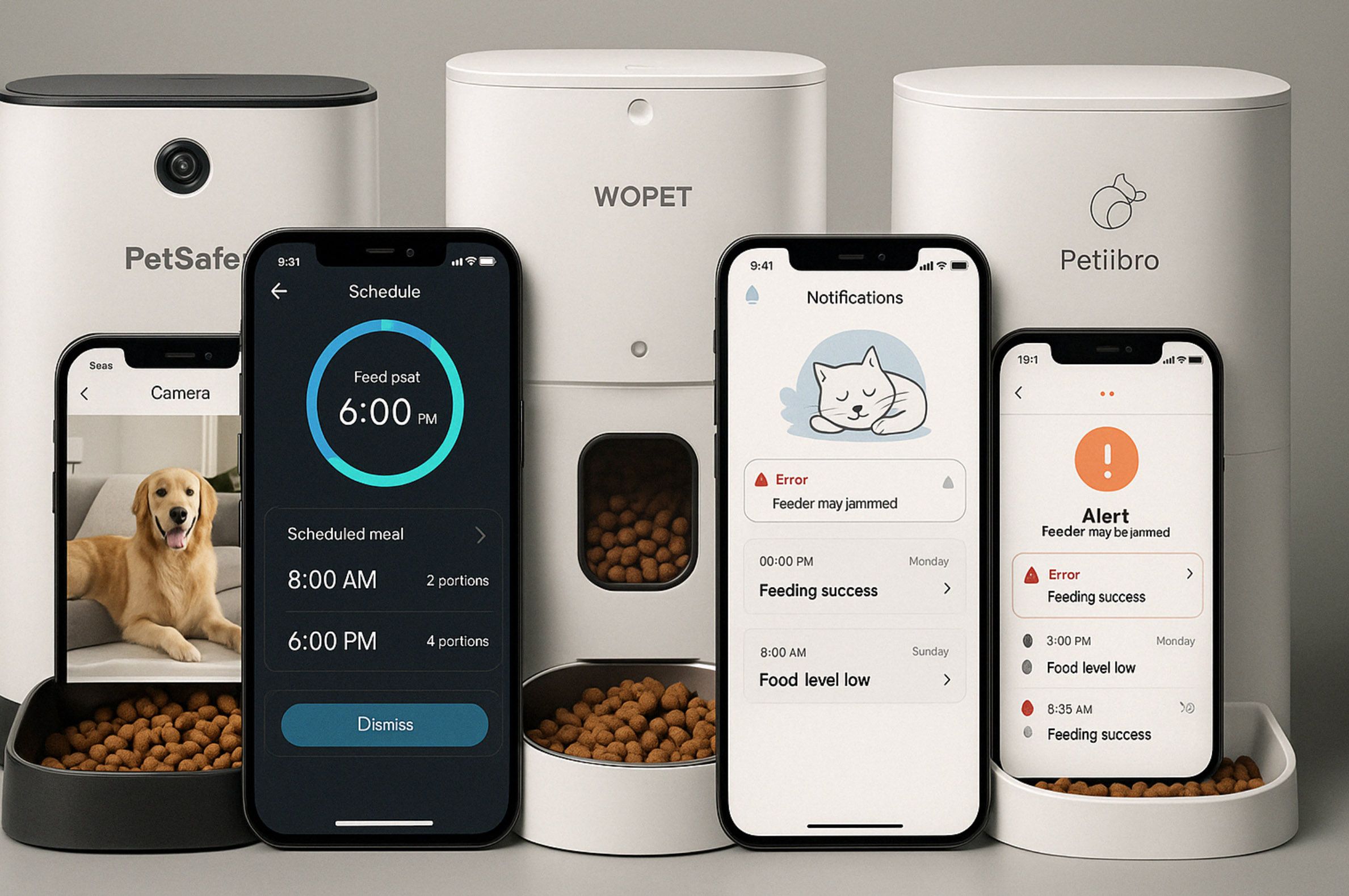
9. Conclusion: Embracing Innovation for Enhanced Pet Well-being
As technology continues to infiltrate every corner of modern life, the way we care for our pets is undergoing a fundamental transformation. What was once a matter of routine and habit is now becoming data-driven, responsive, and intelligently managed. Smart pet feeders sit at the heart of this evolution — but the real innovation lies not in the mechanics of dispensing food, but in the software that powers the experience.
A well-designed mobile application is no longer a “nice-to-have.” It is the gateway to trust, engagement, and loyalty. It’s the interface through which users feel control and reassurance. It’s where the emotional connection between owner and pet is preserved — especially when physical presence isn’t possible. And more than anything else, it’s the component that defines the value of your smart pet feeder in a competitive market.
Throughout this article, we’ve explored the full landscape: from core features like scheduling and alerts to complex architectures, connectivity demands, and case studies of success and missed opportunities. We’ve seen that the best products on the market combine reliable hardware with purpose-built, custom software that’s secure, adaptive, and user-focused.
But what separates a functioning app from a great one isn’t the feature checklist — it’s intentional design, technical excellence, and real-world empathy. Building that kind of app requires a partner who understands not just mobile interfaces, but embedded systems, cloud sync, behavioral UX, and the emotional nuance of caregiving products.
That’s what A-Bots.com delivers.
We don’t build generic apps — we build digital ecosystems that elevate your hardware and empower your users. We treat every line of code as a promise — that the pet will be fed on time, the owner will be informed, and the experience will feel intuitive, reliable, and alive.
If your company is developing — or planning to launch — a smart pet feeder or water dispenser, now is the time to move beyond basic integrations and into truly differentiated digital experiences. Whether you’re optimizing a flagship product or scaling a new line across global markets, the mobile application you deploy will determine how your product is remembered.
Let’s make it remarkable.
Contact A-Bots.com — and let’s build the future of pet care together.
Hashtags
#PetTech
#SmartPetFeeder
#IoTApps
#MobileAppDevelopment
#ConnectedDevices
#PetCareInnovation
#SmartHome
#CustomSoftware
#ABots
#SmartFeeding
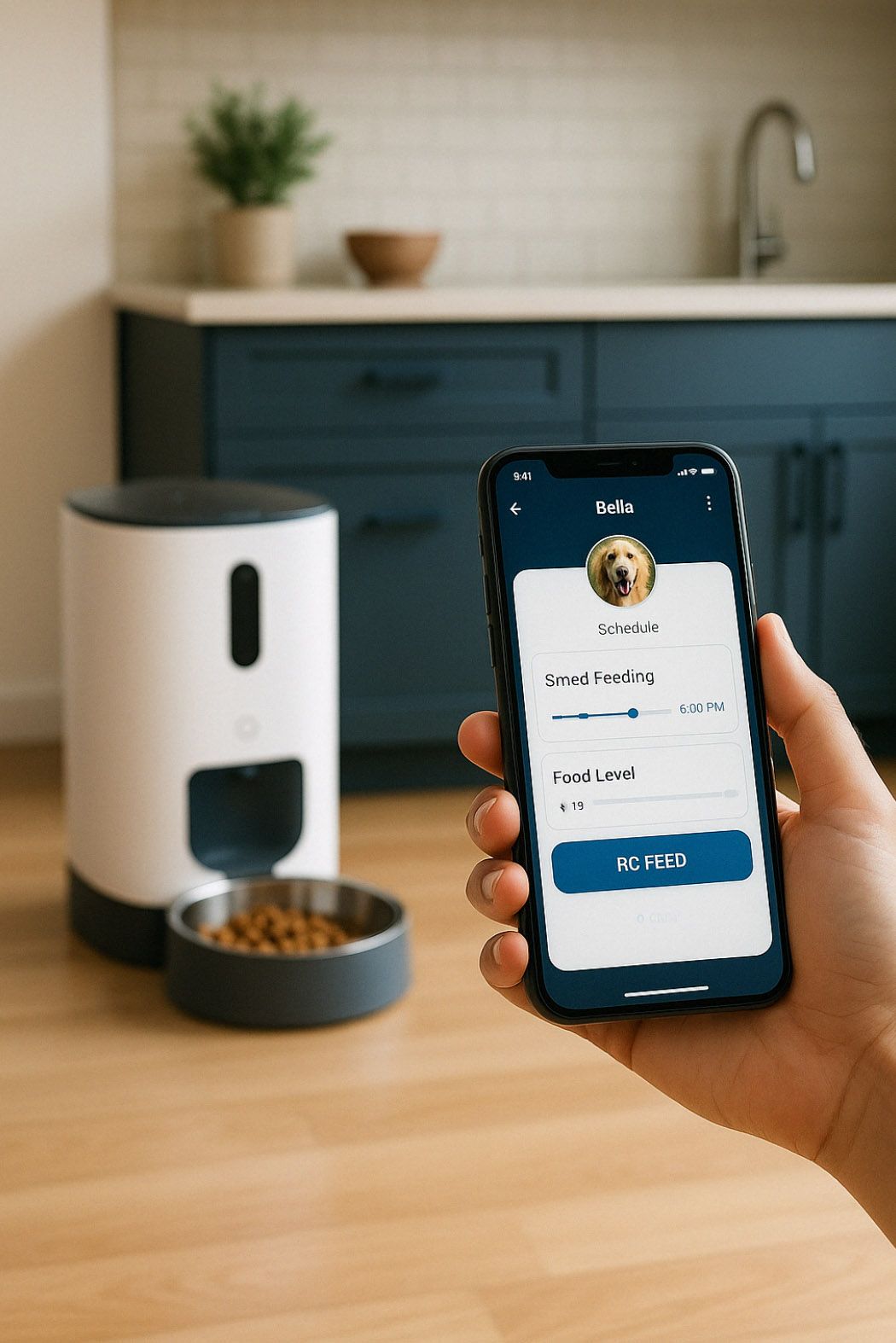
Other articles
Custom CRM for Real Estate Developers Off-the-shelf CRM tools weren’t built for the complexity of real estate development — but we were. This in-depth article explores why custom CRM solutions are redefining how developers manage projects, leads, teams, and revenue. See real-world ROI calculations, key challenges, and expert insights from A-Bots.com, a top CRM development company.
Custom Agriculture App Development for Farmers In 2024, U.S. farmers are more connected than ever — with 82% using smartphones and 85% having internet access. This article explores how mobile applications are transforming everyday operations, from drone-guided field scouting to livestock health tracking and predictive equipment maintenance. It examines why off-the-shelf apps often fail to address specific farm needs and how collaborative, farmer-funded app development is gaining momentum. Through real-world examples and step-by-step guidance, readers will learn how communities of growers can fund, design, and launch custom apps that fit their exact workflows. A-Bots.com offers tailored development services that support both solo farmers and agricultural groups. With offline capabilities, modular design, and support for U.S. and international compliance, these apps grow alongside the farm. Whether you're planting soybeans in Iowa, raising cattle in Texas, or running a greenhouse in California — this article offers the tools and inspiration to build your own farm technology. Discover why more farmers are saying: we don’t wait for the future — we build it.
Custom Drone Mapping Software & Control Apps: Smarter Aerial Solutions by A-Bots.com Custom drone software is revolutionizing how industries operate—from precision agriculture to infrastructure inspection. This article explores why off-the-shelf apps fall short, how AI and modular design shape the future, and how A-Bots.com delivers tailored drone solutions that truly fit. Whether you manage crops, assets, or entire projects, the right software lifts your mission higher.
Custom IoT for Smart Greenhouses and Vertical Farms Modern greenhouses and vertical farms demand more than off-the-shelf solutions. In this article, discover how custom IoT systems — built around your space, your crops, and your team — can unlock new levels of efficiency, automation, and yield. Packed with real-world examples, insights from A-Bots.com engineers, and expert advice, this guide will inspire your next step in smart agriculture. If you're ready to grow smarter — start here.
Custom Coffee Machine App Development Smart coffee is no longer just about flavor — it's about experience. Discover how custom mobile apps for coffee machines unlock new revenue streams, elevate user engagement, and enhance brand loyalty. Backed by real IoT projects, A-Bots.com delivers world-class app solutions that blend tech with taste. Brew the future with us.
Custom Mobile App Development for Smart Wine Cabinets Smart wine cabinets are revolutionizing how wine is stored, served, and experienced. But without a tailored mobile app, their potential remains untapped. This article explores how custom app development turns connected appliances into lifestyle platforms. From inventory tracking and AI-powered recommendations to enterprise-grade restaurant integrations, the right app changes everything. We cover technical architecture, design principles, and real-world use cases. Whether you're a wine lover, hotelier, or hardware brand, you'll discover why mobile UX is now core to wine storage. A-Bots.com delivers expert, future-ready solutions tailored to this niche.
Mobile App Development for Lawn Mowers Smart lawn mowers are transforming how homeowners and businesses manage outdoor spaces. But without powerful software, even the best mower is just hardware. This article explores how custom mobile apps enhance the robotic mowing experience with features like GPS mapping, dynamic scheduling, and real-time feedback. From residential use to commercial landscaping, the impact is clear. We examine the tech architecture behind connected mowers and the critical role apps play in user satisfaction. You'll also learn why off-the-shelf solutions fall short — and how A-Bots.com builds tailored experiences that go far beyond expectations. Whether you're a manufacturer or a visionary startup, this article offers a roadmap to the future of lawn automation.
Top stories
Copyright © Alpha Systems LTD All rights reserved.
Made with ❤️ by A-BOTS
